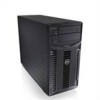Dell PowerEdge T410 Hardware Owner's Manual - Page 28
LCD Status Messages (Optional - error code 1
 |
View all Dell PowerEdge T410 manuals
Add to My Manuals
Save this manual to your list of manuals |
Page 28 highlights
LCD Status Messages (Optional) The LCD messages refer to events recorded in the System Event Log (SEL). For information on the SEL and configuring system management settings, see the systems management software documentation. NOTE: If your system fails to boot, press the System ID button for at least five seconds until an error code appears on the LCD. Record the code, then see "Getting Help" on page 185. Table 1-2. LCD Status Messages Code Text Causes Corrective Actions N/A SYSTEM NAME A 62-character string that This message is for can be defined by the user information only. in the System Setup program. You can change the system ID and name in The SYSTEM NAME the System Setup displays under the program. See "Entering following conditions: the System Setup • The system is powered Program" on page 62. on. • The power is off and active errors are displayed. E1000 Failsafe Check the system event voltage error. log for critical failure Contact events. support. Remove AC power to the system for 10 seconds and restart the system. If the problem persists, see "Getting Help" on page 185. E1114 Ambient Temp Ambient temperature has See "Troubleshooting exceeds a reached a point outside System Cooling allowed range. of the allowed range. Problems" on page 161. 28 About Your System















